- Regulatory Status
- RUO
- Other Names
- Kit Ligand, KITLG, Mast cell growth factor, MGF, Steel factor, SLF, Stem Cell Factor
- Ave. Rating
- Submit a Review
- Product Citations
- publications
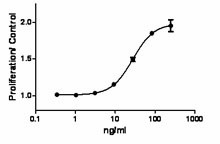
-

TF-1 cell proliferation induced by mouse SCF
SCF (KITL) is a hematopoietic growth factor, and it can synergize with a number of other cytokines to stimulate growth of hemopoietic progenitors in vitro and stimulates blood cell production in vivo. SCF is encoded by Sl ('steel'), a gene critical to the development of several distinct cell lineages during embryonic life. KITL was identified as a soluble protein; nevertheless, the predicted amino acid sequence indicates that it is an integral transmembrane protein. KITL is generated by proteolytic cleavage from a transmembrane precursor. Two splice variants have been described for KITL, and proteolytic processing of both transmembrane protein products occurs on the cell surface. The binding of KITL, induces the dimerization of the KIT molecule, followed by a change in the configuration of the intracellular domain and the autophosphorylation of the receptor, opening several docking sites for signal transduction molecules. Dysregulation of SCF–KI signaling and gain-of-function KIT mutations contribute to the genesis of many cancers, like acute myeloid leukemia, gastrointestinal stromal tumors, and mastocytosis.
Product DetailsProduct Details
- Source
- Mouse SCF, amino acids Lys26-Ala189 (Accession# M59915) was expressed in E. coli.
- Molecular Mass
- The 165 amino acid N-terminal methionylated recombinant protein has a predicted molecular mass of 18298.0 Da. The DTT-reduced protein migrates at approximately 18 kDa by SDS-PAGE. The non-reduced protein migrates at approximately 14 kDa by SDS-PAGE.
- Purity
- >98%, as determined by Coomassie stained SDS-PAGE.
- Formulation
- 0.22 µm filtered protein solution is in 10 mM NaH2PO4 pH 7.2, 0.15M NaCl.
- Endotoxin Level
- Less than 0.01ng per µg cytokine as determined by the LAL method.
- Concentration
- 10 and 25 µg sizes are bottled at 200 µg/mL. 100 µg size and larger sizes are lot-specific and bottled at the concentration indicated on the vial. To obtain lot-specific concentration and expiration, please enter the lot number in our Certificate of Analysis online tool.
- Storage & Handling
- Unopened vial can be stored between 2°C and 8°C for up to 2 weeks, at -20°C for up to six months, or at -70°C or colder until the expiration date. For maximum results, quick spin vial prior to opening. The protein can be aliquoted and stored at -20°C or colder. Stock solutions can also be prepared at 50 - 100 µg/mL in appropriate sterile buffer, carrier protein such as 0.2 - 1% BSA or HSA can be added when preparing the stock solution. Aliquots can be stored between 2°C and 8°C for up to one week and stored at -20°C or colder for up to 3 months. Avoid repeated freeze/thaw cycles.
- Activity
- ED50 = 5 - 20 ng/ml, corresponding to a specific activity of 0.5 - 2.0 x 105 units/mg, as determined by the dose dependent stimulation of TF-1 cell proliferation.
- Application
-
Bioassay
- Application Notes
-
BioLegend carrier-free recombinant proteins provided in liquid format are shipped on blue-ice. Our comparison testing data indicates that when handled and stored as recommended, the liquid format has equal or better stability and shelf-life compared to commercially available lyophilized proteins after reconstitution. Our liquid proteins are verified in-house to maintain activity after shipping on blue ice and are backed by our 100% satisfaction guarantee. If you have any concerns, contact us at tech@biolegend.com.
- Product Citations
-
Antigen Details
- Structure
- Cytokine
- Distribution
-
SCF is widely exppressed
- Function
- SCF has pleiotropic functions. It is involved in melanogenesis, gametogenesis, hematopoiesis and brain angiogenesis.
- Interaction
- The KIT receptor tyrosine kinase (RTK) is expressed in hematopoietic stem cells (multipotent hematopoietic stem cells, progenitors committed to myeloid and/or erythroid lineages, and T and B cell precursors), mast cells, and acute myeloid leukemia cells.
- Ligand/Receptor
- SCF binds to the extracellular domains of the KIT receptor tyrosine kinase.
- Cell Type
- Embryonic Stem Cells, Hematopoietic stem and progenitors
- Biology Area
- Angiogenesis, Cell Biology, Immunology, Signal Transduction, Stem Cells
- Molecular Family
- Cytokines/Chemokines, Growth Factors
- Antigen References
-
1. Sun L, et al. 2006 Cancer Cell 9:287-300.
2. Magnol, et al. 2007 BMC Dev Biol. 7:81.
3. Liu H, et al. 2007 EMBO J 26:891-901.
4. Agosti V, et al. 2004 J. Exp. Med. 199:867-878.
5. Huang L el al.1992 Mol Cell Biol 3:349-362.
6. Kitamura T, et al. 1989 J. Cell Physiol. 140:323-334. - Gene ID
- 17311 View all products for this Gene ID
- UniProt
- View information about SCF on UniProt.org
Related FAQs
- Why choose BioLegend recombinant proteins?
-
• Each lot of product is quality-tested for bioactivity as indicated on the data sheet.
• Greater than 95% Purity or higher, tested on every lot of product.
• 100% Satisfaction Guarantee for quality performance, stability, and consistency.
• Ready-to-use liquid format saves time and reduces challenges associated with reconstitution.
• Bulk and customization available. Contact us.
• Learn more about our Recombinant Proteins. - How does the activity of your recombinant proteins compare to competitors?
-
We quality control each and every lot of recombinant protein. Not only do we check its bioactivity, but we also compare it against other commercially available recombinant proteins. We make sure each recombinant protein’s activity is at least as good as or better than the competition’s. In order to provide you with the best possible product, we ensure that our testing process is rigorous and thorough. If you’re curious and eager to make the switch to BioLegend recombinants, contact your sales representative today!
- What is the specific activity or ED50 of my recombinant protein?
-
The specific activity range of the protein is indicated on the product datasheets. Because the exact activity values on a per unit basis can largely fluctuate depending on a number of factors, including the nature of the assay, cell density, age of cells/passage number, culture media used, and end user technique, the specific activity is best defined as a range and we guarantee the specific activity of all our lots will be within the range indicated on the datasheet. Please note this only applies to recombinants labeled for use in bioassays. ELISA standard recombinant proteins are not recommended for bioassay usage as they are not tested for these applications.
- Have your recombinants been tested for stability?
-
Our testing shows that the recombinant proteins are able to withstand room temperature for a week without losing activity. In addition the recombinant proteins were also found to withstand four cycles of freeze and thaw without losing activity.
- Does specific activity of a recombinant protein vary between lots?
-
Specific activity will vary for each lot and for the type of experiment that is done to validate it, but all passed lots will have activity within the established ED50 range for the product and we guarantee that our products will have lot-to-lot consistency. Please conduct an experiment-specific validation to find the optimal ED50 for your system.
- How do you convert activity as an ED50 in ng/ml to a specific activity in Units/mg?
-
Use formula Specific activity (Units/mg) = 10^6/ ED50 (ng/mL)
 Login/Register
Login/Register 







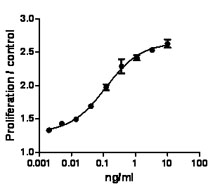
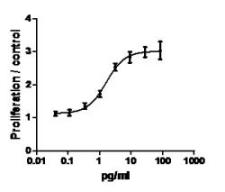
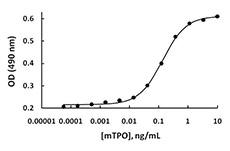
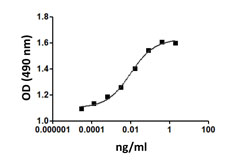



Follow Us